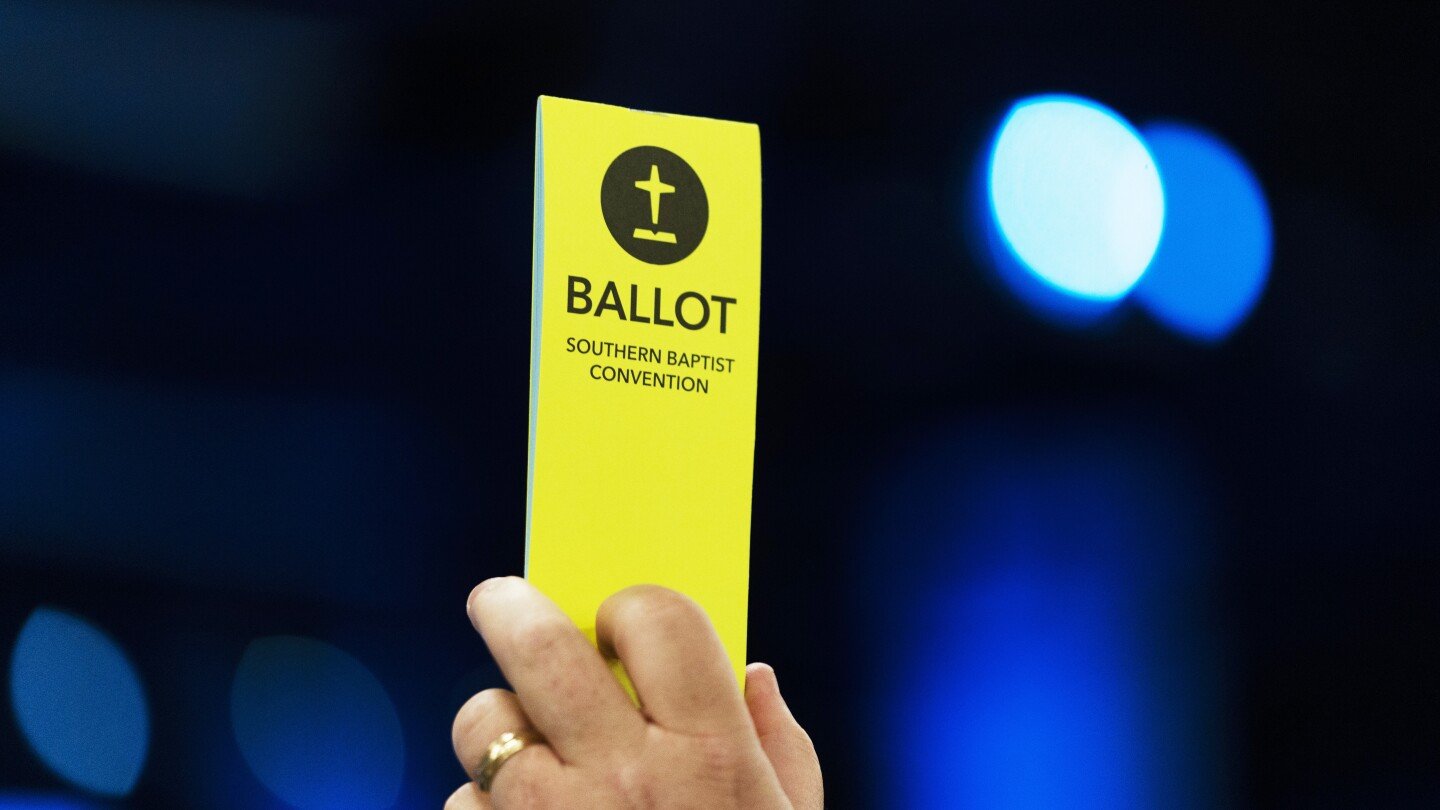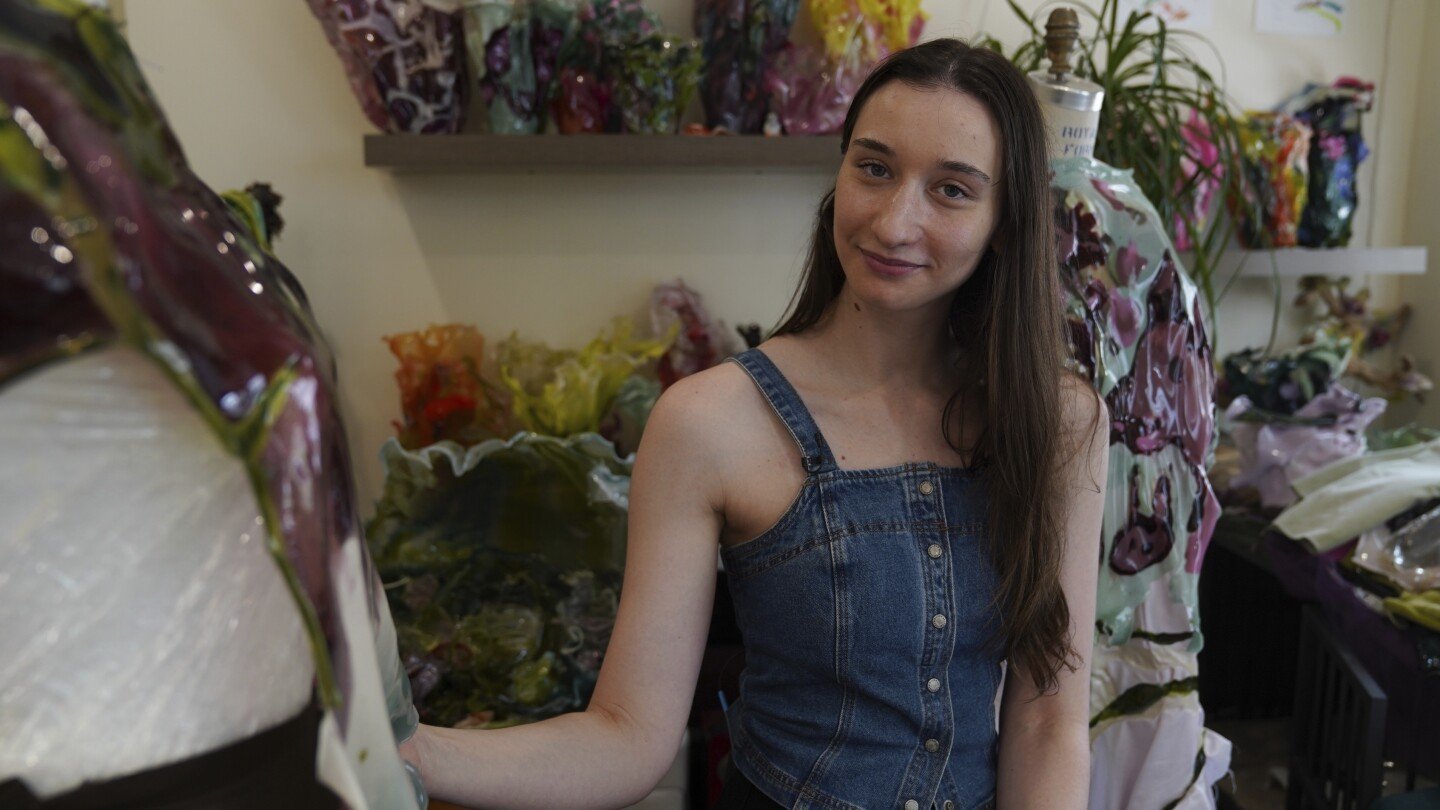Lifestyle
Southern Baptists to meet in Dallas for annual evangelical gathering

Southern Baptists meeting this week in Dallas will be asked to approve resolutions calling for a legal ban on pornography and a reversal of the U.S. Supreme Court’s approval of same-sex marriage.
The proposed resolutions call for laws on gender, marriage and family based on what they say is the biblically stated order of divine creation. They also call for legislators to curtail sports betting and to support policies that promote childbearing.
The Southern Baptist Convention, the nation’s largest Protestant denomination, is also expected to debate controversies within its own house during its annual meeting Tuesday and Wednesday — such as a proposed ban on churches with women pastors. There are also calls to defund the organization’s public policy arm, whose anti-abortion stance hasn’t extended to supporting criminal charges for women having abortions.
Messengers stand for worship during a Southern Baptist Convention annual meeting Tuesday, June 11, 2024, in Indianapolis. (AP Photo/Doug McSchooler, File)
In a denomination where support for President Donald Trump is strong, there is little on the advance agenda referencing specific actions by Trump since taking office in January in areas such as tariffs, immigration or the pending budget bill containing cuts in taxes, food aid and Medicaid.
Remnants of the epic showdown in Dallas 40 years ago
Southern Baptists will be meeting on the 40th anniversary of another Dallas annual meeting. An epic showdown took place when a record-shattering 45,000 church representatives clashed in what became a decisive blow in the takeover of the convention — and its seminaries and other agencies — by a more conservative faction that was also aligned with the growing Christian conservative movement in presidential politics.
The 1985 showdown was “the hinge convention in terms of the old and the new in the SBC,” said Albert Mohler, who became a key agent in the denomination’s rightward shift as longtime president of the Southern Baptist Theological Seminary in Louisville, Kentucky.
Attendance this week will likely be a fraction of 1985’s, but that meeting’s influence will be evident. Any debates will be among solidly conservative members.
Many of the proposed resolutions — on gambling, pornography, sex, gender and marriage — reflect long-standing positions of the convention, though they are especially pointed in their demands on the wider political world. They are proposed by the official Committee on Resolutions, whose recommendations typically get strong support.
A proposed resolution says legislators have a duty to “pass laws that reflect the truth of creation and natural law — about marriage, sex, human life, and family” and to oppose laws contradicting “what God has made plain through nature and Scripture.”
To some outside observers, such language is theocratic.
“When you talk about God’s design for anything, there’s not a lot of room for compromise,” said Nancy Ammerman, professor emerita of sociology of religion at Boston University. She was an eyewitness to the Dallas meeting and author of “Baptist Battles,” a history of the 1980s controversy between theological conservatives and moderates.
“There’s not a lot of room for people who don’t have the same understanding of who God is and how God operates in the world,” she said.
Mohler said the resolutions reflect a divinely created order that predates the writing of the Scriptures and is affirmed by them. He said the Christian church has always asserted that the created order “is binding on all persons, in all times, everywhere.”
Southern Baptist views more politically viable today
Separate resolutions decry pornography and sports betting as destructive, calling for the former to be banned and the latter curtailed.
At least some of these political stances are in the realm of plausibility at a time when their conservative allies control all levers of power in Washington and many have embraced aspects of a Christian nationalist agenda.
A Southern Baptist, Mike Johnson, is speaker of the House of Representatives and third in line to the presidency.
At least one Supreme Court justice, Clarence Thomas, has called for revisiting the 2015 Supreme Court decision legalizing same-sex marriage nationwide. Other religious conservatives — including some in the Catholic postliberal movement, which has influenced Vice President JD Vance — have promoted the view that a robust government should legislate morality, such as banning pornography while easing church-state separation.
And conservatives of various stripes have echoed one of the resolution’s call for pro-natalist policies and its decrying of “willful childlessness which contributes to a declining fertility rate.”
Some call for eliminating Ethics and Religious Liberty Commission
Some preconvention talk has focused on defunding the Ethics and Religious Liberty Commission, the Southern Baptist Convention’s public policy arm, which has been accused of being ineffective. Ten former Southern Baptist presidents endorsed its continued funding, though one other called for the opposite.
A staunchly conservative group, the Center for Baptist Leadership, has posted online articles critical of the commission, which is adamantly anti-abortion but has opposed state laws criminalizing women seeking abortions.
The commission has appealed to Southern Baptists for support, citing its advocacy for religious liberty and against abortion and transgender identity.
“Without the ERLC, you will send the message to our nation’s lawmakers and the public at large that the SBC has chosen to abandon the public square at a time when the Southern Baptist voice is most needed,” said a video statement from the commission president, Brent Leatherwood.
A group of Southern Baptist ethnic groups and leaders signed a statement in April citing concern over Trump’s immigration crackdown, saying it has hurt church attendance and raised fears. “Law and order are necessary, but enforcement must be accompanied with compassion that doesn’t demonize those fleeing oppression, violence, and persecution,” the statement said.
The Center for Baptist Leadership, however, denounced the denominational Baptist Press for working to “weaponize empathy” in its reporting on the statement and Leatherwood for supporting it.
Texas pastor Dwight McKissic, a Black pastor who shares many of the Southern Baptist Convention’s conservative stances, criticized what he sees as a backlash against the commission, “the most racially progressive entity in the SBC.”
“The SBC is transitioning from an evangelical organization to a fundamentalist organization,” he posted on the social media site X. “Fewer and fewer Black churches will make the transition with them.”
Amendment to ban churches with women pastors
An amendment to ban churches with women pastors failed in 2024 after narrowly failing to gain a two-thirds supermajority for two consecutive years. It is expected to be reintroduced.
The denomination’s belief statement says the office of pastor is limited to men, but there remain disagreements over whether this applies only to the lead pastor or to assistants as well. In recent years, the convention began purging churches that either had women as lead pastors or asserted that they could serve that role. But when an SBC committee this year retained a South Carolina megachurch with a woman on its pastoral staff, some argued this proved the need for a constitutional amendment. (The church later quit the denomination of its own accord.)
The meeting comes as the Southern Baptist Convention continues its long membership slide, down 2% in 2024 from the previous year in its 18th consecutive annual decline. The organization now reports a membership of 12.7 million members, still the largest among Protestant denominations, many of whom are shrinking faster.
More promising are Southern Baptists’ baptism numbers — a key spiritual vital sign. They stand at 250,643, exceeding pre-pandemic levels and, at least for now, reversing a long slide.
___
Associated Press religion coverage receives support through the AP’s collaboration with The Conversation US, with funding from Lilly Endowment Inc. The AP is solely responsible for this content.
Lifestyle
These flavor-packed pork burgers were inspired by Indian street food

These flavor-packed burgers are a spin on a spiced pork sausage from Goa in southern India, based on the garlicky, European-style chouriço introduced by Portuguese settlers. To combat the humidity of the region and prolong the shelf life of the sausage, the meat is heavily salted and flavored with a mixture of spices and tangy vinegar.
Goan sausage is ubiquitous in southern India, where you can find it sold at street food carts and high-end restaurants alike, sometimes baked into a bun or minced and stuffed between layers of fried naan.
In this recipe from our cookbook “ Milk Street 365: The All-Purpose Cookbook for Every Day of the Year,” we take inspiration from those burger-like sandwiches, using a combination of grated garlic, garam masala, cumin, paprika and cayenne to give the all-pork patties deep, complex flavor and a rusty hue. Grating the garlic ensures it melts into the meat without any distracting bits. Instead of naan, we use classic hamburger buns.
Egg and panko bread crumbs help the patties keep their shape. Don’t undermix the pork mixture; be sure to combine it well so the breadcrumbs and seasonings are evenly distributed.
These burgers are especially delicious topped with yogurt, torn fresh mint leaves and thin slices of cucumber or tomato.
Start to finish: 35 minutes
Servings: 4
Ingredients:
⅔ cup panko breadcrumbs
¼ cup plain whole-milk yogurt, plus more to serve
5 teaspoons garam masala
5 teaspoons sweet paprika
1 tablespoon ground cumin
½ teaspoon cayenne pepper
2 large egg yolks
2 medium garlic cloves, finely grated
Kosher salt and ground black pepper
1 pound ground pork
2 tablespoons grapeseed or other neutral oil
4 hamburger buns, toasted
Directions:
In a large bowl, combine the panko, yogurt, garam masala, paprika, cumin, cayenne, egg yolks, garlic, ¾ teaspoon salt, ½ teaspoon pepper and ¼ cup water. Using a fork, mash the mixture into a smooth paste. Add the pork and mix with your hands until evenly combined. Form into 4 patties, each about 4 inches in diameter, place on a large plate and refrigerate for 15 minutes.
In a 12-inch nonstick skillet over medium, heat the oil until barely smoking. Add the burgers and cook until well browned, 7 to 8 minutes. Flip, reduce to medium-low and continue to cook until the patties are well browned on the second sides and the centers reach 160°F, another 5 to 7 minutes. Transfer to a clean plate, tent with foil and let rest for 5 minutes. Serve on the buns with additional yogurt on the side.
EDITOR’S NOTE: For more recipes, go to Christopher Kimball’s Milk Street at 177milkstreet.com/ap
Lifestyle
Fashion designers experiment with natural supplies called biomaterials

NEW YORK (AP) — At her kitchen stove, fashion designer Caroline Zimbalist looks like an alchemist at work as she stirs a pot full of corn starch and a thickener made from seaweed. The peppermint-scented mixture glitters as she carefully pours it into silicone molds of hearts and leaves.
When the material hardens, Zimbalist will stitch it into unique, made-to-order dresses that she sells on her website. She hopes her designs, which have been worn by celebrities including Chappell Roan, will put a spotlight on materials that aren’t sourced from planet-polluting fossil fuels, such as oil.
“It’s almost like a vessel to show the world,” she said.
Other small-scale designers are testing out tapioca, gelatin and other kitchen-shelf ingredients. Meanwhile, big names such as Adidas and Hermes have experimented with mushroom leather, while the Lycra brand is incorporating a new largely corn-based material into stretch fabric. Some experts are skeptical that these textiles — commonly referred to as biomaterials — will go mainstream, but designers such as Zimbalist hope their experiments will set an example for larger brands to follow.
Over 60% of clothing comes from petroleum-based synthetics like polyester, according to Textile Exchange, a nonprofit that promotes sustainable fashion. Manufacturing those materials creates emissions. Synthetic garments can also shed microplastics during washing. And as fast-fashion brands pump out new clothes for customers who expect new designs every few weeks, many garments end up in landfills.
A piece by fashion designer Caroline Zimbalist is displayed on Friday, June 6, 2025, in the Queens borough of New York. (AP Photo/Mary Conlon)
Zimbalist’s designs gained attention in 2024 when Roan wore one on “The Tonight Show.” The New York-based designer has since dressed stars such as comedian Atsuko Okatsuka and actors Anna Lore and Reneé Rapp. She takes commissions for custom clothing pieces, which cost between $150 and $1,200, via her website, which notes her “unique recipe of biodegradable and natural materials.”
As to whether her approach could be reproduced at a larger scale, Zimbalist says her materials could most practically be used to replace plastic hardware such as buttons and zippers. She acknowledges they can be sticky if not dried correctly, stinky if not treated and melty if exposed to extreme heat.
“Even incorporating it in small ways to start would be really strong,” she said.
Why biomaterials are hard to find
Fossil-fuel derived fabrics are ubiquitous because they’re cheap and made from plentiful raw materials, said Dale Rogers, an Arizona State University professor who studies supply chains.
Many clothes are also made of materials that come from plants or animals such as cotton, silk, wool and cashmere. But some have environmental impacts. Cotton uses a lot of water. Sheep and goats burp out methane.
Some biomaterials have gotten closer to widespread use. Mycelium leather, made from mushrooms, has been used to create luxury shoes, accessories and handbags by brands such as Stella McCartney, Lululemon, Adidas and Hermes.
Still, Rogers said he’s not convinced there’s enough demand for alternative materials to overcome companies’ aversion to the higher costs of producing them at a large scale.
“Honestly, in the end, cost drives almost all decisions,” he said.
Wrinkles in aiming for sustainability
Getting larger companies to use alternative materials depends on whether they will pay more for a fabric that matches their values, said Jon Veldhouse, the CEO of Qore LLC.
His company makes a product called Qira that replaces about 70% of the fossil-derived components of elastic synthetic fabrics with a corn-based material. The Lycra Company, which sells its stretchy material to major brands, initially expects to incorporate Qira in around 25 percent of its Spandex business, said Lycra chief brand and innovation officer Steve Stewart. But that option will be more expensive, and they haven’t yet announced any takers.
It can also be hard to measure the sustainability of farming practices that go into producing raw materials for new fabrics. Cargill is Qore’s partner and corn supplier, and it gets its grain from farmers in the vicinity of their processing plant. Veldhouse said many already plant cover crops or reduce tilling to lower environmental impact, but he couldn’t provide data on how many use those approaches.
Sarah Needham, a senior director at Textile Exchange, said it’s great to see a large organization such as Lycra making its production systems more sustainable. But she also stressed the industry needs to reduce its overreliance on virgin materials, perhaps considering agricultural waste as a source of fabric.
The role of experimental designers
Needham said experimental designers are often the ones coming up with those alternatives to virgin materials and building appetite for new approaches.
But small designers might not have the resources to test the biodegradability of their materials, which often do involve processing, even if it’s by hand, said Ramani Narayan, an engineering professor at Michigan State University.
“If I take something — like seaweed or whatever it is — and I apply a process to it, then I can no longer call it natural,” he said.
Zimbalist, the New York designer, acknowledges that her materials aren’t ready to replace conventional fabrics and that her work is more of “a piece that leads to larger conversations.”
Rogers, of Arizona State, thinks the fashion industry is a long way from meaningful change, but that “it’s incredibly valuable” for artists and specialty manufacturers to try new materials.
“What they’re doing is likely to have long-term benefit, maybe even after their lifetimes,” he added.
___
Follow Melina Walling on X @MelinaWalling and Bluesky @melinawalling.bsky.social.
Follow Kiki Sideris on X @KikiSideris.
___
The Associated Press’ climate and environmental coverage receives financial support from multiple private foundations. AP is solely responsible for all content. Find AP’s standards for working with philanthropies, a list of supporters and funded coverage areas at AP.org.
Lifestyle
Most teens see college as key to jobs and life skills, AP-NORC poll says

PHOENIX (AP) — Most American teenagers say it is important to them to graduate from college, with girls especially describing it as a key step for accomplishing their life goals, according to a new poll.
Teenagers also generally are more upbeat than adults on college despite concerns about tuition costs, soaring student loan debt and the politicization of many issues in higher education.
Overall, about 6 in 10 teens say it’s “extremely” or “very” important to them to graduate from college, according to the survey from The Associated Press-NORC Center for Public Affairs Research, which was conducted this spring among teenagers between the ages of 13 and 17. That compares with about 4 in 10 adults who said the same in a UChicago Harris/AP-NORC poll from 2022.
The survey also found that many teens think it will be harder for them to achieve major life milestones — like owning a home, raising a family or reaching a good standard of living — than it was for their parents.
For Ry-n Uyeda, 17, the biggest concern about college is the prospect of being away from her home in Waianae, Hawaii. Uyeda is already taking college-level courses in high school and hopes to play softball at a university on the West Coast.
Uyeda said she wants to develop time management skills and endurance to handle the pressures of being a student-athlete. But she hopes the college experience does not change who she is.
“I want to remember where I came from and the values that I’ve learned from here,” said Uyeda, who attends Waianae High School. “Going to a new place with new people in a new environment, I just want to still be myself.”
Far more girls than boys see value in college
Seven in 10 teenage girls in the survey said it was at least “very” important to them to graduate from college, compared with 54% of teenage boys.
The disparity reflects a growing gender gap in college degree completion. In 1995, young men and women were equally likely to hold a bachelor’s degree. Since then, a gap has emerged, with 47% of U.S. women ages 25-34 completing a bachelor’s degree compared with 37% of men, according to a Pew Research Center analysis of census data.
Teens raised in households with higher incomes and parents who went to college themselves also are more likely to view higher education as important.
Jalena Crawford, a 16-year-old high school junior, said she hopes to attend Grand Canyon University or Arizona State University to become a professional American Sign Language interpreter. She said her plans have been encouraged by relatives with college degrees and it would be “weird” not to consider higher education.
“I didn’t really start thinking about college until I started liking ASL. I was trying to figure out what I was going to do,” Crawford said.
Most teens see a college education as a vital step for their future career prospects, although they see other benefits as well.
About 7 in 10 teenagers said completing college is “extremely” or “very” important for getting good jobs, and about 6 in 10 teenagers say a degree is valuable in learning necessary life skills. About half of teens see college as key for either becoming a more informed member of society or forming their personal identity, according to the survey.
Teens think life milestones will be harder for them to achieve
Teenagers have many of the same life goals as adults, such as owning a home and raising a family, the poll found. About 8 in 10 teenagers value being able to pursue what they enjoy, having a good standard of living and having a successful career.
But few teenagers believe those goals have gotten easier to achieve for their generation compared with their parents.
About 7 in 10 teenagers believe owning a home has become harder to achieve for them compared with their parents, according to the poll. Just over half of teenagers say it’s become more challenging for their generation to raise a family. About half say that about having a good standard of living, having a successful career or traveling the world. Fewer, about 4 in 10, say it’s grown harder to graduate from college or be able to pursue what they enjoy.
Evarist Bego, 22, graduated earlier this year from the University of Southern California with a joint degree in business and film. He said he recalls wanting to go to college and then work his way up in his chosen industry but “that’s just not how it works anymore.”
It’s harder than he anticipated to find a job, which he said may owe partly to the creative industry he chose. He sees mostly temporary positions, like internships or fellowships.
“So many jobs that I see are entry-level, but then they require three-plus years of experience. I have interned in school, I had some experience, but it’s not enough,” he said.
___
Sanders reported from Washington.
___
The Associated Press’ education coverage receives financial support from multiple private foundations. The AP is solely responsible for all content. Find the AP’s standards for working with philanthropies, a list of supporters and funded coverage areas at AP.org.
___
The AP-NORC poll of 1,060 teens ages 13-17 was conducted April 30-May 14, using a sample drawn from NORC’s probability-based AmeriSpeak Panel Teen Panel, which is designed to be representative of teenagers in the U.S., and interviews from opt-in online panels. The margin of sampling error for teens overall is plus or minus 4.2 percentage points.
-

 Sports3 days ago
Sports3 days agoBill Ackman: Swift backlash after billionaire’s pro debut
-

 Europe5 days ago
Europe5 days agoBondi and Hegseth might be messing up — but they’re doing what Trump picked them to do
-

 Lifestyle4 days ago
Lifestyle4 days agoSebeiba festival in Algeria carries on ancient tradition
-

 Africa5 days ago
Africa5 days agoGreece blocks asylum claims after surge in migrant arrivals
-

 Lifestyle4 days ago
Lifestyle4 days agoHealthy workday snacks include a smart mix of energy-boosters
-

 Lifestyle3 days ago
Lifestyle3 days agoOne Tech Tip: All the ways to unsubscribe, after ‘click-to-cancel’ was blocked
-

 Asia5 days ago
Asia5 days agoSouth Korea’s former President Yoon Suk Yeol back in custody over insurrection probe
-

 Europe3 days ago
Europe3 days agoAs South Korea becomes a key arms supplier to US allies, its best customer is on the edge of a warzone




